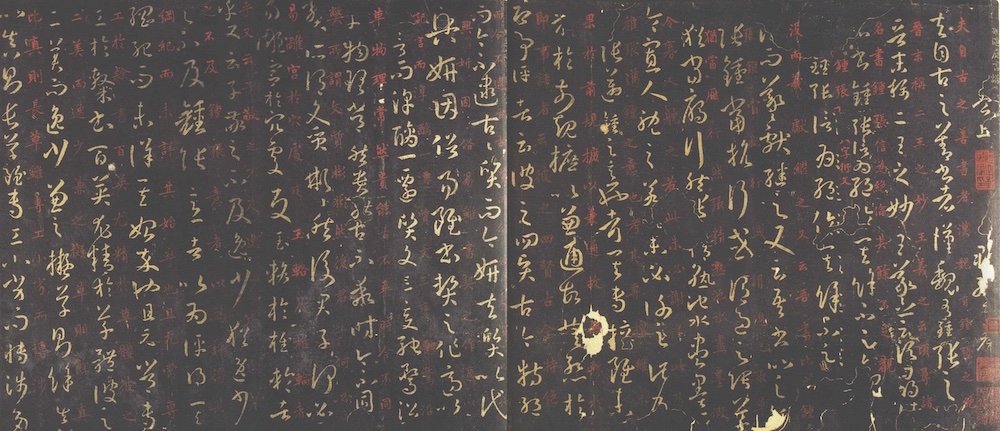Shupu 書譜 "Notes on calligraphy" is a treatise on calligraphy written during the Tang period 唐 (618-907) by Sun Guoting 孫過庭 (646-691) that was finished in 687.
Sun Guoting, courtesy name Qianli 虔禮, hailed from Fuyang 富陽 (modern Fuyang, Zhejiang) and served as administrator of the helmet section of the right guard (youwei zhoucao canjun 右衛胄曹參軍). He was famous for his expertise in the three styles of the standard script (zhenshu 真書), the cursive "running script" (xingshu 行書) and the super-cursive "grass script" (caoshu 草書).
Sun rated all earlier books on calligraphy as too crude, unsystematic and dated (for instance, regarding the "isolating" standard script zhangshu 章書) and decided to write a theory on this kind of art. His book had an original length of 6 chapters, spread over 2 juan. Unfortunately, only part of the text, no more than 3,500 characters, has survived. The Song-period 宋 (960-1279) book Xuanhe shupu 宣和書譜 says that the surviving text belonged to the preface, while other experts think it was part of the first chapter.
The Shupu described the styles and rules of the regular and the grass script and discussed the six styles of characters (liushu 六書) and the eight forms (bati 八體) in detail. He characterizes these styles and says that the seal script (zhuan 篆書) was elegant but precise (wan er tong 婉而通), the chancery script (li 隸) refined and dense (jing er mi 精而密), the grass script fluid and smooth (liu er chang 流而暢), and the isolating standard script (zhangshu) grandiose yet convenient (xian er bian 險而便). All these writings styles were, he said, not new, but a perfect calligrapher would see his work as a kind of dedication to achieve elegant demeanour, he would warm his heart to create an enchanting result, he would agitate his brush so that he would "dry the shaft", and he would attune all words so that he would achieve an elegant ensemble.
The text of the Shupu was very refined and elegant, but not easy to understand. Zhang Huaiguan 張懷瓘 (early 8th cent.), author of the book Shuduan 書斷, nevertheless criticised Sun Guoting's book as a comprehensive and deep-going treatise on Chinese calligraphy. Although the surviving part of Sun Guoting's book is in many parts relatively obscure and hard to understand, it became one of the most influential texts on calligraphy in ancient China. Furthermore, the text has survived both in calligraphic shape, based on a stone inscription, and in printed form. Hundreds of calligraphers used the inscription as a model to learn the art of calligraphy. Accordingly, the Shupu text and its calligraphic shape were often admired and commented on.
 |
National Palace Museum 典藏精選, Taibei (ROC) |
 |
Print of the Shupu created in 1087 by Master Xue (Xue keben 薛刻本) from Hedong 河東. On a rubbing of the plate made in 1872, Jiang Xihan 蔣錫韓 added transliterations to each character, written with cinnabar ink. Seals and prefaces were added in 1876 and 1904. From Shi 2004. |
The surviving part of the Shupu is included in the series Baichuan xuehai 百川學海, Shuofu 說郛, Wangshi shuhua yuan 王氏書畫苑 and Siku quanshu 四庫全書. In 1982, the Shanghai Guji Chubanshe 上海古籍出版社出版 published a critical study by Zhu Jianxin 朱建新. The Shupu has been translated by Chang Chʻung-ho and Hans H. Frankel (1995), Two Chinese Treatises on Calligraphy, New Haven: Yale University Press, together with Jiang Kui's 姜夔 (1161-1203?) Xu shupu 續書譜.
There is another book with the title Shupu (Sŏpo) written by the Korean scholar An Qi (An Ki) 安歧 (1683-?), courtesy name Yizhou (Ŭichu) 儀周, style Lucun (Lokch'on) 鹿村 or Songquan Laoren (Songch'ŏn loin) 松泉老人. An Qi was a collector living in Tianjin 天津 during the early Qing period 清 (1644-1911). He has also written another book on calligraphy, Moyuan huiguan (Muk-yŏn hoi-kwan) 墨緣彙觀. His book of 2 juan length was intended as a commentary on Sun Guoting's book. It was influenced by the commentated on by Chen Xiangquan 陳香泉 (1921-2009), who had written on the surviving parts of Sun's Shupu that were transmitted together with Dou Xi's 竇息 (fl. 769) book Shushufu 述書賦.